The Bagpipe Society
Macedonian Gajda – history, style and techniques
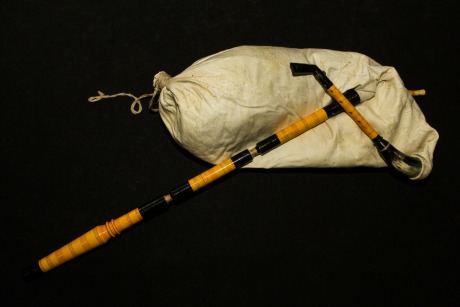
The characteristics of the Gajda
The Gajda is part of a family of bagpipes which are found throughout an area which today includes Montenegro, southern Serbia, Albania, Macedonia, northern Greece, Bulgaria, the Turkish Thrace and the eastern plains of Romania. The bagpipes that are found in these territories have common characteristics in that they have a cylindrical chanter and a drone which have single reeds and bags made from a sheep or a whole goat. The same style, techniques and musical possibilities of that gajda are also found throughout the region.
The Gajda is the main instrument for dance in Macedonia and it has always been linked with shepherds, although today you can often hear it played, accompanied by synthesisers, at a wedding in a restaurant in Skopje. Besides having a historically important role in dance in Macedonia (as well as in Bulgaria and Northern Greece), the gajda is also the instrument most closely linked with the cultural roots of the Slavs: many claim it is among the few musical instruments in Macedonia that was not imported from Turkey or, more generally, from the East. There are many famous sayings concerning the gajda, such as “a wedding without a gajda is like a funeral”, or near the Rodopi mountains (the epicenter of the Thracian bagpipe) “here, out of every two people, three play the gajda”.

A gajda is made up of at least four parts: the bag, the blowpipe, the chanter and the drone. The bag is normally made with the skin of a sheep or a whole goat. It is said that the sheep is more suitable for a gajda in higher temperatures, such as summer, while the goat one is more suited to winter climates. The lower legs of the animal are removed and the skin is closed with a knot often made from the inside, although there are examples where it is on the outside. The stocks (in Macedonian glavini) for the blowpipe and the drone and inserted in the holes from the front legs and the chanter is inserted into a horn stock installed in the animal’s ‘neck’. The chanter (gajdanica or gajdarka) is traditionally a turned piece of boxwood decorated with characteristic ring motifs in horn. In the lower part of the chanter, a bell is inserted which is made of carved horn which carries the last two holes of the chanter. A side hole for the intonation of the lowest note of the chanter is pierced in the end part of the horn. It is thought that this is a remnant of an effective use of the entire horn of an animal, a characteristic that can still be found in other types of bagpipes from both the Mediterranean and Central-Eastern Europe.
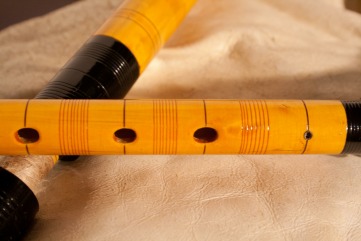
The Gajdanica has seven front holes and one rear hole. The seventh hole, which is at the top of the chanter, is defined as a “flea hole”, in Macedonia it is called mamorka. This hole is decidedly smaller than the other holes and, perpendicular to the hole itself, there is a small internal cylindrical section which contains the final part of the stem of a bird’s quill. The most important feature of the flea hole, in addition to being a tone hole allowing you to play the main scale on the gajda, is to raise a semitone the main positions of gajda allowing more chromatic possibilities. This small hole is found on all the bagpipes throughout the Thracian region but is also characteristic of other types of neighboring instruments, such as the Hungarian duda and, in general, the Eastern European bagpipes. In Macedonia it is particularly important for as well as modulating from major to minor and other scales, it allows the characteristic vibrato.
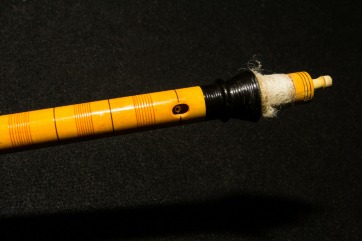
Another typical feature of the gajda is to have the tonic hole with four fingers of the left hand lowered. This arrangement of the intervals therefore allows the instrument to have an extension of a fifth up and a fourth down. Gajda uses a predominantly closed fingering, where the hands close all the holes and a single finger is raised corresponding to the hole of the note to be played. This technique allows a great speed in the execution of embellishments that involve the lower notes, moreover the lower sounds of the chanter are mixed with the sound of the tonic of the drone, thus simulating a staccato effect when playing. The Macedonian gajdanica (as well as the chanter of the Bulgarian kaba gajda) has a sort of inverse taper at the end of the chanter, which does not conflict with the predominant cylindrical bore (which is responsible, together with the single reed, for the sound of the chanter) but it helps differentiate the registers of the instrument. In practice there is a mixed technique where the closed fingering is alternated with semi-closed fingers so that the lower notes can be heard; for example in the execution of a lower mordent. In this case you will also raise your finger below the note you are playing.

The development of a technique so refined and complex in its ornamentation (so much as to rival the more famous bagpipe Scottish tradition) comes from the fact that, like all bagpipes, the sound of gajda is continuous and plays at a consistent volume thus preventing the player from playing pauses and dynamic variations of the sound.

Throughout the region one can find different sizes of gajda in different pitches. In Macedonia itself, before the second half of the 20th century, it was not difficult to find both very sharp sounding bagpipes and more deep sounding bagpipes. With the advent of Radio Skopje and thanks to the player Pece Atanasovski, the gajda has become standardised on the type of instrument found in Prilep, the city in southern Macedonia where Pece Atanasovski came from. This gajda sounded in “B♭” while today the one in “A” is more widespread.
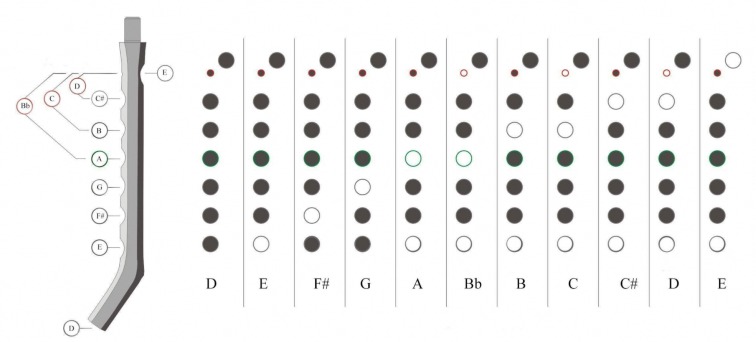
The function of the drone, in Macedonian ruĉalo or brĉalo, is to keep the tonic note of the instrument constantly two octaves below that of the chanter. This part of the instrument is usually divided into three pieces so that the tubes can slide between them to tune the drone to the tonic. Normally, the drone is placed on the right shoulder (unlike western bagpipes where it is placed on the left) but it can also rest on the right arm or be suspended downwards. There are instruments equipped with a small additional drone that plays the tonic at the same pitch as the chanter.
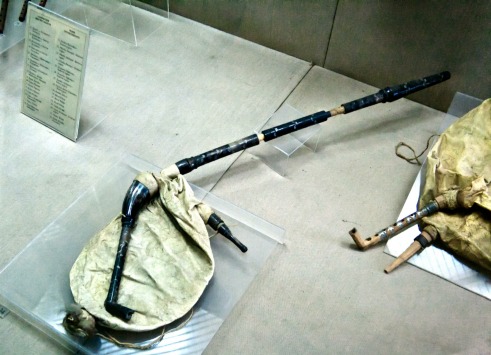
The reeds of the chanter and the drone, in Macedonian “piska ”, are both single: where the vibrating lamella is cut directly into the cane tube and the drone reed is about twice the size of the chanter’s reed. This type of reed, together with the rather wide holes of the chanter, give the gajda a powerful and wild sound.
The Gajda is associated with ancient rural, agricultural societies in the Southern Balkans which were traditionally inward looking with regards to their economic, social and cultural aspects. Until the beginning of the 20th century this area was part of the Ottoman Empire and was therefore inhabited by a mosaic of different peoples: Slavs, Turks, Pomaks, Bulgarians and Roma people. But the Gajda was an instrument, like the kaval, which was shared by all of these cultures not only being part of the musical life but also in association with feast and rituals. However, the urbanization and the abandonment of agricultural societies, together with the enormous success of the clarinet, undermined the social context of gajda in these traditional rural areas. In the Balkan agricultural society the Gajda belonged to the male world with young shepherds playing the instrument whilst the women would learn a vocal repertoire at home. The two genres were separate but would come together at feasts when male and female musical worlds would be united. We don’t know if the Muslim population ever played gajda but in the absence of a definite answer, any practice would have been stopped due to the population exchanges between 1919 and 1923 between Greece and Bulgaria and Greece and Turkey. What we find today is that the gajda has remained the preserve of the Christian Slavophone or Greek-speaking populations.
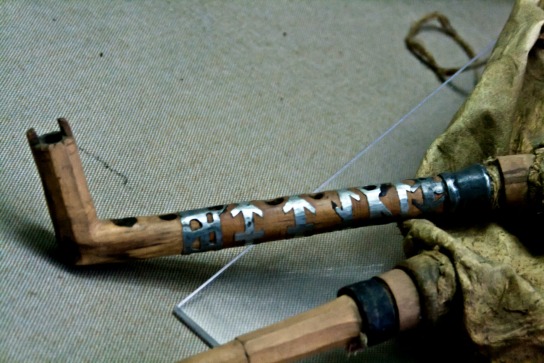
The dissemination and standardization of the gajda in Macedonia: Pece
Atanasovski
Before the foundation and popularity of Radio Skopje, the gajda was not built at a particular standardised pitch as it did not play with other instruments. Traditionally it was played as a solo instrument, possibly accompanied by the tapan (drum). As well as having different sizes and pitches of bagpipe, there were also different styles of playing the instrument depending on the region. It is known, for example, that the gajda style of the region around Skopje is much more elaborate and rich in ornamentation than the gajda style played in the south of the area. Two people who created a watershed for this instrument were Mile Kolarov and Pece Atanasovski. Mile Kolarov, an excellent kaval player, also played the gajda, having studied with Todor Boŝkov, the father of the famous singer, Vaska Ilieva. Born in 1927, Petre Vasilev “Pece” Atanasovski came from the village of Dolneni (Prilep). As a child he was a sheperd and receiving only elementary education as his family could not afford more. His family were excellent musicians of gajda and ŝupelka and Petre began playing musical instruments when he was only five. From 1944 to 1947 he served in the army before moving to Skopje where he worked as a clerk for a clothing factory. In this period he even managed to complete his school studies and start his studies at a music school.
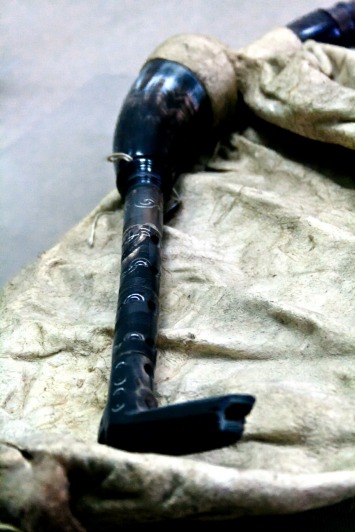
In Skopje Pece distinguished himself as a dancer in several amateur ensembles. He also led his village troupe to various festivals in the late ‘40s, a time when traditional costumes were still regularly worn and each village had its own dances and songs. In 1950 Pece joined the then nascent “Tanec” state ensemble, before taking up a musical director position of a small ensemble for Skopje Radio and Television. Here he worked under the direction of the professor of ethnomusicology Dr. Žifko Firfov and together they set a standard for traditional music and instruments. Pece was also the artistic director of the folk ensemble “Makedonija”. These activities led Atanasovski to travel through villages in Macedonia seeking out groups and musicians, especially singers, who were then recorded for the radio. In 1970, together with Firfov, he began holding a series of summer schools and seminars in the States where Macedonian dances and songs were taught. These seminars attracted the attention of many enthusiasts from North America, Western Europe and Japan.
Through these various ways, Pece Atanasovski imposed his own style nationwide as the way to play the gajda in the similar way that Mile Kolarov did with regards to the kaval. It seems that Atanasovski did not particularly like the fact that Kolarov also played the gajda to the point of encouraging him to play only the kaval. The style of Pece Atanasovski, although unique and very personal, coincides with the musical style of Prilep and the south of Macedonia; so also the instrument that today is built throughout Macedonia, the “Prilepska gajda” (a rather large bagpipe in “B♭” or “A”), comes from that region.
How to play Macedonian gajda: Style and practice
Melodic ornamentation and vibrato characterises the aesthetics of the gajda sound. The use of vibrato predominates in slow compositions, where notes are held for a long time. In the fasterdance music, the ornamentation is very thick and applied to any note with a value that is longer or equal to the basic rhythm unit. Recent research indicates that the use of vibrato characterizes a repertoire that is idiomatic of gajda, whereas it is not widespread in the repertoires of other instruments such as the zurla (double reed oboe). Apart from the idiomatic differences between gajda and kaval, the style and the embellishments of the two instruments are almost identical. Being an instrument with a continuous sound and closed fingering, gajda takes more advantage of the lower appoggiatura on the note “E” in case they want to separate the notes or create the effect of staccato. It is also possible to easily play certain notes very fast; for example high “E”, holding six fingers down (low “E”), raising only the left thumb and then lowering it.
The vibrato on the gajda is identical to that of the kaval. A type of trill can be obtained from any note of the gajda, by raising and lowering the flea hole very quickly. Whilst in the Bulgarian style it is obtained through a slight movement of the fingers which are not lifted completely from the tone hole, in the Macedonian one the fingers rise completely and go back very quickly giving rise to something very similar to a trill. In the Bulgarian style vibrato is regular and follows the rhythm of the composition while in the Macedonian one it is more irregular and ‘nervous’. Bulgarian players scornfully define this kind of vibrato as “koze vibrato” “or “vibrato of the goats “. In Macedonia, this type of vibrato is called in Macedonian “mrdanje” оr “ukrasuvanje” . The Gajda also uses another type of vibrato (like the kaval) called “klepanje” where the vibrato is obtained by raising and lowering the fingers rhythmically (mainly of the right hand) in the holes below the note that is to be vibrated. The change in height due to the momentary passage from the open fingering to the closed one, giving the vibrato. This type of vibrato is widely used in the most acute notes, especially those that the flea hole does not allow to vibrate ie “D” and “E”. Even “C” can not be performed with the vibration of the flea hole (for the natural “C”, in fact, uses a fork position that provides to hold the index finger of the left hand on the flea hole), then raises and lowers very quickly the hole of “C” itself (middle finger of the left hand) obtaining an identical result.
In gajda, the most common ornamentations are lower and upper acciaccatura, appoggiatura (mostly lower), turns (gruppetto) and both upper and lower mordents. The hole of the left thumb, which corresponds to the sharpest note of the instrument is used, opening and closing it at tempo during a melody. This is done to highlight the rhythm that, especially in the strong beats of the metre, is broken by thenote as if it was a “rhythmic upper acciaccatura” or even a “percussion inside the instrument”. This technique is more developed in areas where the gajda does not traditionally play with the tapan, such as Greek and Bulgarian Thracia.
Links between regional vocal and gajda technique
What makes the study of gajda playing practices more interesting is undoubtedly the link that it shares with the practice of singing. All the traditional instruments are inspired by melodic movements, embellishments and style of the human voice. But as far as the gajda is concerned, we are instead faced with a sort of parallelism in which it is difficult to establish which came first – the voice style or the gajda. Several studies have shown how the vocal timbre used (that is an open and nasal throat) is almost that of the gajda. Moreover, different types of ornamentation used in song find their most spontaneous and idiomatic origin in gajda. This would lead to at least three interesting conclusions: gajda is probably one of the oldest musical instruments of the Balkans, gajda was probably used as an accompaniment to singing, gajda is the material projection of the music of the Balkan cultures.
If you compare the area of diffusion of this type of song, known in the West thanks to the famous Le Mystère des Voix Bulgares ( “the mysterious Bulgarian voices”), it can been seen that it coincides exactly with the reach of the gajda. The gajda possesses a range, or ambitus, of an octave divided into two registers: the high register above the tonic and the lower one below the tonic. Many compositions use an ambitus of a sixth (more subtonic base pentacord) while the low register is used for fast passages. The bass register is used more substantially in certain slow songs derived from the vocal repertoire.
Traditional festivities such as Christmas, Carnival or Easter, would normally be celebrated outside in the village square and involve all the local population. The particularly high sound of gajda made it the ideal instrument for this type of occasion and these were also the rare occasions were the male musical world (characterized by gajda) and the female one (characterized by singing) were united. So if a band only consists of a few players and before the advent of amplification, then it will be necessary to play an instrument, such as the gajda, which could be heard in the middle of a noisy square. The so-called “open-throated” vocal technique allows a singer to be heard in a situation like the one described above: the voice is projected directly from the throat, assisted to a minimum extent by the resonance provided by the head and nose. We quote Timothy Rice when he writes “one of the side effects of this loud and projected sound at long distances, is the release of air and sound when it should end. In place of a sudden or even gradual pause, the typical means of ending a note held at the end of a sentence is a sound, usually of guttural tone and severe register, obtained by a glottal stop “. Rice continues by asserting that “the glottal stop, in general, is an important means of separating one note from the other. Some singers emit a note of acute height one octave higher than the tonic with the same function, separate two notes “.
Comparing this technique to that of gajda we can now say that this way of singing represents the equivalent of the continuous sound of gajda. The severe and guttural sound takes place in the song mainly at the beginning of the phrases, while the acute sound is used to separate the sounds but also at the end of the musical phrases. Women sing with an unusually sharp and shrill timbre and the intonation roughly matches the tonic of gajda. It would seem that women have adapted their vocal range to that of gajda which is generally better suited to the male voice. It is no coincidence that men regularly sing at this range while women, if they do not sing along with one gajda, normally they prefer to sing their songs a fourth or a fifth below. There is a very interesting study by Haris Sarris “Singing like the gaida” which highlights the analogies between the voice and the Thracian gajda through sophisticated analysis which considers the height of the amplitude and the spectrum of the sound. These analyses focused on three fundamental characteristics that the author claims to be shared by the voice and the gajda in the Balkans: ornaments, vibrato and timbre.
As for ornaments, Haris identifies two types of ornaments in gajda: high ornaments and low ornaments. The high ornaments exploit the highest note of gajda, are used within the melodic line, during the repetition of a note or at the end of a sentence. The low ornaments exploit the lower note of the gajda and are mainly used during the repetition of a note or if a pause effect is needed. The same ornaments are later identified in the singing practices: high-pitched tones used to sharpen notes or at the end of sentences and low-pitched tones used at the beginning or end of a sentence.
Regarding the vibrato, Sarris identifies and analyzes two types: the “pitch vibrato” obtained with the flea hole and the “impulse vibrato” obtained with the technique klepanje. The analyses show how the vibrato of the gajda exposes the vibrato note, rather than an oscillation around it, to an alternation between the note itself and a higher pitch value. The analysis of the sound spectrum of the voice of the singers of the same area shows how the vibrato is different from that used, for example, by the western opera singers. Their method is perfectly controlled in terms of scale and length, resulting in a uniform and defined vibrato. However, the vibrato of the Thracian singers reveals a variation of pitch and intensity very marked but also more irregular.
To conclude, Haris argues that when a note is played with the gajda, both the note and the tonic of the drone play at the same time. The spectrum of this sound is therefore very rich in harmonics of both the chanter and the drone. The notes above the tonic up to the fifth show peaks in the high frequencies (above 4 KHz), while the notes below the tonic reveal much lower peaks above 4 KHz. The lower note of the gajdarka “E” shows an even lower inclination in the high frequencies and is particularly poor in harmonics. Once again the analysis of the singing in Thrace has a mirror in the spectrum and timbre of the gajda. Studies have shown that singers use effects and expedients that only an uninterrupted flow of music like that of gajda (but also of many other musical instruments of the Balkan and Anatolian area) can offer: fast trills, vibrato, glissato, acciaccature and mordenti. Moreover, the timbre of the voices, bright and wild, using an open throat technique giving rich harmonics, all seems to imitate the sounds and style of the gajda.
It cannot be clearly established which practice has influenced the other but it can certainly be said that in the Southern Balkans the instrumental tradition of gajda and the vocal one, at least until recent urbanization and the spread of amplification, have represented the same face of a musical approach.
In a future edition of Chanter Fabio will take a further look at gajda playing techniques and music.
Thanks to Jane Moulder for editing the text of this article**.**
RICE Timothy, Poliphony in Bulgarian Folk Music, ph.D. Dissertation, University of Washington, 1977
SARRIS Haris, TZEVELEKOS Panagiotis, Singing like the Gaida (Bagpipe): Investigating Relations between Singing and Instrumental Playing Techniques in Greek Thrace, Journal of Interdisciplinary Music Studies, volume 2, issue 1&2, art.#0821203, pp. 33-57, 2008
- Data Processing Notice (GDPR)
-
@BagpipeSociety on X (formally known as Twitter)
-
TheBagpipeSociety on Instagram
-
 BagpipeSociety on Facebook
BagpipeSociety on Facebook
Something wrong or missing from this page? Let us know!
